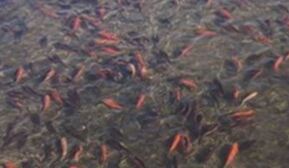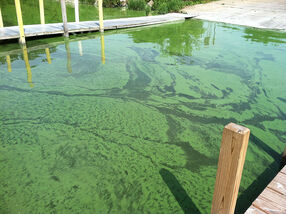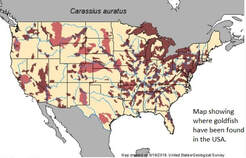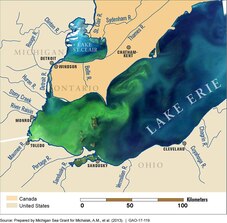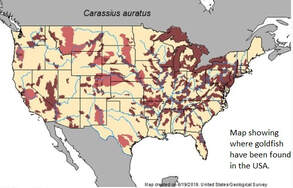
Golden Invader
By Marcerlean Green,
Dossin elementary, Detroit, MI
Grade 5
Click on the image to download a printable version of this lesson plan
We would greatly appreciate your feedback! Click here to complete a short survey telling us about your experience with this lesson plan.
By Marcerlean Green,
Dossin elementary, Detroit, MI
Grade 5
Click on the image to download a printable version of this lesson plan
We would greatly appreciate your feedback! Click here to complete a short survey telling us about your experience with this lesson plan.
Lesson Overview
Unit Driving Question: How do invasive species affect the ecosystem of the Great Lakes?
Lesson Level Question: Why are goldfish considered an invasive species?
• Students will investigate how goldfish got into the Great Lakes and whether they are invasive species. The students will create informational text that will provide information on GOLDFISH and their invasive habits in the great lakes.
• Together, students will create a Great Lakes food chain with and without GOLDFISH and will explore the questions: Could goldfish be the cause of algal blooms in a lake? Are they the cause of the algal bloom in Lake Erie?
The lesson is expected to take 120 minutes (two 60-minute lessons)
Sources Consulted
Background about these phenomena can be found on the following web sites:
https://www.arcgis.com/apps/MapJournal/index.html?appid=510f12b73dc14b449e07dd181bbfbfba
https://www.youtube.com/watch?v=Ahnr94mX_vM
https://www.youtube.com/watch?v=Zysydqn6P1o
http://root-cause-analysis.info/2015/07/09/small-goldfish-can-grow-into-a-large-problem-in-the-wild/
Also: “Invasive goldfish draw concern from wildlife officials: https://www.apnews.com/5bec91823f574d16bf81535392300eda
State Officials classify goldfish as an invasive species. The aquarium pets are domesticated carp originally bred in China. Goldfish can carry diseases and bacteria that harm the ecosystem and other marine animals and among other misplaced aquatic species causing damage in Alaska.”
5 things to know about Great Lakes goldfish - https://www.mlive.com › news › 2016/04 › lake_erie_goldfish https://www.mlive.com/news/2016/04/great_lakes_goldfish.html
Learning Target
How do invasive species affect the ecosystem of the Great Lakes
What are five aquatic invasive species that live in Michigan?
Why and how are GOLDFISH an invasive species?
Michigan Science Standards Addressed
SEP:
5-LS2-1 Develop a model to describe the movement of matter among, plants, animals, decomposers, and the environment.
Science and Engineering Practices:
#1 Asking questions and defining problems.
#2 Developing and using models
#3 Planning and carrying out investigations.
#4 Analyzing and Interpreting data
#6 Constructing explanations and designing solutions.
#8 Obtaining, evaluating, and communicating information.
DCI: Disciplinary Core Ideas
CCC: Cross Cutting Concepts
List of Materials
- Poster Boards
- Markers/ Color Pencils
- Computer
- White and Colored card stock
- Tape
- One set of 16 Aquatic Invasive Species Game Cards (8 species cards; 8 characteristics cards): Shuffle Cards with Invasive Species and their characteristics
New Vocabulary
Unit Driving Question: How do invasive species affect the ecosystem of the Great Lakes?
Lesson Level Question: Why are goldfish considered an invasive species?
• Students will investigate how goldfish got into the Great Lakes and whether they are invasive species. The students will create informational text that will provide information on GOLDFISH and their invasive habits in the great lakes.
• Together, students will create a Great Lakes food chain with and without GOLDFISH and will explore the questions: Could goldfish be the cause of algal blooms in a lake? Are they the cause of the algal bloom in Lake Erie?
The lesson is expected to take 120 minutes (two 60-minute lessons)
Sources Consulted
Background about these phenomena can be found on the following web sites:
https://www.arcgis.com/apps/MapJournal/index.html?appid=510f12b73dc14b449e07dd181bbfbfba
https://www.youtube.com/watch?v=Ahnr94mX_vM
https://www.youtube.com/watch?v=Zysydqn6P1o
http://root-cause-analysis.info/2015/07/09/small-goldfish-can-grow-into-a-large-problem-in-the-wild/
Also: “Invasive goldfish draw concern from wildlife officials: https://www.apnews.com/5bec91823f574d16bf81535392300eda
State Officials classify goldfish as an invasive species. The aquarium pets are domesticated carp originally bred in China. Goldfish can carry diseases and bacteria that harm the ecosystem and other marine animals and among other misplaced aquatic species causing damage in Alaska.”
5 things to know about Great Lakes goldfish - https://www.mlive.com › news › 2016/04 › lake_erie_goldfish https://www.mlive.com/news/2016/04/great_lakes_goldfish.html
Learning Target
How do invasive species affect the ecosystem of the Great Lakes
What are five aquatic invasive species that live in Michigan?
Why and how are GOLDFISH an invasive species?
Michigan Science Standards Addressed
SEP:
5-LS2-1 Develop a model to describe the movement of matter among, plants, animals, decomposers, and the environment.
Science and Engineering Practices:
#1 Asking questions and defining problems.
#2 Developing and using models
#3 Planning and carrying out investigations.
#4 Analyzing and Interpreting data
#6 Constructing explanations and designing solutions.
#8 Obtaining, evaluating, and communicating information.
DCI: Disciplinary Core Ideas
- LS2: Ecosystem, Interactions, Energy, and Dynamics
- LS4: Biological Evolution, Unity, and Diversity
- ETS1: Engineering Design
CCC: Cross Cutting Concepts
- CCC #2 Cause and Effect
- CCC #4 System and System Models
- CCC #7 Stability and Change
List of Materials
- Poster Boards
- Markers/ Color Pencils
- Computer
- White and Colored card stock
- Tape
- One set of 16 Aquatic Invasive Species Game Cards (8 species cards; 8 characteristics cards): Shuffle Cards with Invasive Species and their characteristics
New Vocabulary
- Invasive species: a non-native species that causes harm to the environment, human health, or the economy
- Great Lakes: five freshwater lakes of central North America between the United States and Canada, including Lakes Superior, Michigan, Huron, Erie, and Ontario.
- Algae Blooms: a rapid growth of microscopic algae (single celled plants that contain chlorophyll) or cyanobacteria (these also contain chlorophyll) in water, often resulting in a colored scum on the surface.
- Goldfish: aquarium pet fish that are domesticated carp that were originally bred in China. Often bright orange, they can have many different color patterns.
- Food Consumption: the eating, drinking, or ingesting of something for nutrition
- Food Web: the natural interconnection of food chains and a graphical representation of what-eats-what in an ecological community
- Sediment: the accumulation of sand and dirt that settles in the bottom of lakes.
- Erosion: A type of weathering in which surface soil and rock are worn away through the action of glaciers, water, and wind
- Primary producer: Usually plants and algae, which perform photosynthesis in order to manufacture their own food source.
- Primary consumer: herbivores eat only plants and algae as their sources of energy.
- Secondary consumer: Animals that consume only herbivores are referred to as secondary consumers.
- Disease: an illness of people, animals, plants, etc., caused by infection or a failure of health rather than by an accident
5E Model Lesson Plan
Engage
Engage
Ask: Is the goldfish natural to these lakes? Could the occurrence of algae blooms be caused by the goldfish?
Explore
Ask driving questions:
Explain
A short explanation is the following: Goldfish have been found in large numbers in some parts of Lake Ontario and Lake Erie. They were probably introduced to the lakes by people disposing of pet goldfish into a stream or pond that ultimately runs into the Great Lakes. Most of the goldfish now found in the Great Lakes probably were born in the Great Lakes as a result of the introduced pet fish. They compete with native fish for food and they may also eat the eggs of native fish. Some scientists think their interactions with sediments and with native herbivores may result in algal blooms. The algal blooms in Lake Erie depend greatly on nutrients that drain off farm fields, but other factors, such as the type of algae or the presence (or absence) of herbivores, may contribute to their recent broad occurrence. The algal blooms in Lake Erie are particularly bad because they are a type of bacteria that produces toxic chemicals that make the water unhealthy to drink and have bad effects (like slowing reproduction and growth) on animals living in the water where the algal blooms occur.
Activity
Elaborate
Evaluate
Student artifacts:
- Description (and perhaps a drawing) of an invasive species, focusing on the distinguishing characteristics of the species
- 5-step action plan poster focusing on solutions to the GOLDFISH invasive species problem.
- GOLDFISH Food Web
Student Discourse:
Turn and Talk
- Knowledge of what an invasive species is.
- The effects of an invasive species once it enters the GREAT LAKES
- The rationale on which species is the most invasive and why
Ask driving questions:
- What are invasive species?
- How do invasive species affect the GREAT LAKES ecosystem?
- What are the reasons why GOLDFISH are considered invasive species in the Great Lakes?
- What effects have GOLDFISH had on the GREAT LAKES ecosystem?
Explain
A short explanation is the following: Goldfish have been found in large numbers in some parts of Lake Ontario and Lake Erie. They were probably introduced to the lakes by people disposing of pet goldfish into a stream or pond that ultimately runs into the Great Lakes. Most of the goldfish now found in the Great Lakes probably were born in the Great Lakes as a result of the introduced pet fish. They compete with native fish for food and they may also eat the eggs of native fish. Some scientists think their interactions with sediments and with native herbivores may result in algal blooms. The algal blooms in Lake Erie depend greatly on nutrients that drain off farm fields, but other factors, such as the type of algae or the presence (or absence) of herbivores, may contribute to their recent broad occurrence. The algal blooms in Lake Erie are particularly bad because they are a type of bacteria that produces toxic chemicals that make the water unhealthy to drink and have bad effects (like slowing reproduction and growth) on animals living in the water where the algal blooms occur.
Activity
- The students will research background information in small groups to organize invasive species cards, and rank the species from, “ Most Invasive,” to “ Least Invasive.”
- Students will then present their findings, and likely ruling out GOLDFISH as the most invasive in the Great Lakes. [however, students may find that in some places GOLDFISH are considered to be most invasive]
- Students will learn what an algae bloom is and consider whether goldfish may have contributed to algae blooms in Lake Erie
- Students will be divided into groups of 3 or 4 and are given 16 shuffled cards- 8 photo cards and 8 characteristic cards.
- Match each invasive species with the corresponding characteristics and impacts on the GREAT LAKES
- Review matches and cards once they are done.
- Rank from “Most,” to “Least,” invasive, and explain the rationale for your ranking.
- Students will discuss whether goldfish might have contributed to algae blooms in Lake Erie or elsewhere in the Great Lakes.
Elaborate
- After presenting their findings, students will create a 5 STEP action plan poster displaying possible solutions to the GOLDFISH invasive species problem while using a GOLDFISH invasive species food web as a reference.
Evaluate
Student artifacts:
- Description (and perhaps a drawing) of an invasive species, focusing on the distinguishing characteristics of the species
- 5-step action plan poster focusing on solutions to the GOLDFISH invasive species problem.
- GOLDFISH Food Web
Student Discourse:
Turn and Talk
- Knowledge of what an invasive species is.
- The effects of an invasive species once it enters the GREAT LAKES
- The rationale on which species is the most invasive and why

New lesson plan ideas are welcome and will be uploaded as they are received and approved.
Instructions for submitting lesson plans for:
About invasive species,
About science and science careers
For information about submitting new lesson plans, please contact jchadde(at)mtu.edu
Lesson plan ideas from other web sites:
From Pennsylvania Sea Grant: 10 lesson plans about interactions of invasive species, biodiversity, and climate change
Creation of the above page of educational resources was funded in part by the Michigan Invasive Species Grant Program through the Departments of Natural Resources, Environmental Quality, and Agricultural and Rural Development.
This material is also based upon work supported by the National Science Foundation under Grant No. 1614187.
Any opinions, findings, and conclusions or recommendations expressed in this material are those of the authors and do not necessarily reflect the views of the National Science Foundation.
Instructions for submitting lesson plans for:
About invasive species,
About science and science careers
For information about submitting new lesson plans, please contact jchadde(at)mtu.edu
Lesson plan ideas from other web sites:
From Pennsylvania Sea Grant: 10 lesson plans about interactions of invasive species, biodiversity, and climate change
Creation of the above page of educational resources was funded in part by the Michigan Invasive Species Grant Program through the Departments of Natural Resources, Environmental Quality, and Agricultural and Rural Development.
This material is also based upon work supported by the National Science Foundation under Grant No. 1614187.
Any opinions, findings, and conclusions or recommendations expressed in this material are those of the authors and do not necessarily reflect the views of the National Science Foundation.
